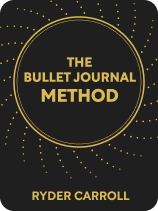

This article is an excerpt from the Shortform book guide to "The Bullet Journal Method" by Ryder Carroll. Shortform has the world's best summaries and analyses of books you should be reading.
Like this article? Sign up for a free trial here .
Thinking of getting started with Bullet Journaling? What role can a Bullet Journal play in your life? What are the major components of a Bullet Journal?
In his book The Bullet Journal Method, Ryder Carroll goes over Bullet Journaling for beginners. He discusses the benefits of keeping a Bullet Journal, the role it can play in your life (beyond the obvious roles of keeping you organized and maintaining your schedule), and how you can customize your Bullet Journal to fit your needs.
Here is an overview of Bullet Journaling basics.
Bullet Journaling Basics
According to Carroll, the only tools Bullet Journaling requires are a notebook and a pen, and there are no limits to which ones you choose. One of the advantages of Bullet Journaling is that it provides flexibility that technology can’t, including in the tools you use. Whether your notebook is large or small and your pen fountain or ballpoint, Carroll says you’re free to decide what will work best for you.
(Shortform note: Even with the freedom to choose the tools you like best, you may be wondering if Carroll has any personal recommendations. In a previous interview, he mentioned that he prefers to use a dot-grid notebook. He even teamed up with the makers of one of the most popular dot-grid notebooks for Bullet Journaling—the Leuchtturm1917—to design an official Bullet Journal notebook.)
Additionally, Carroll maintains that the Bullet Journal Method is all about function over form. Although you’re free to design your journal in whatever way suits you, your choices shouldn’t interfere with the purpose behind the journal’s components, your ability to decipher your handwriting, or your capacity to maintain your journaling habits.
Here are some basic roles and components of Bullet Journaling for beginners.
The Role of Reflection
Carroll explains that, unlike other productivity systems, the Bullet Journal Method encourages you to not only record information but also re-engage with it. Rather than passively listing tasks and reminders, you actively assess what you’ve written through a process he calls migration (which we’ll refer to as transferring).
(Shortform note: Although the Bullet Journal Method may be unique in the specific way it encourages you to re-engage with information, it’s not the only productivity system to have that functionality. Evernote, for example, is a digital app that helps you record information from a diverse set of file types—including notes, voice recordings, photos, and documents—and organize and search them with ease. Such effortless access to information incentivizes you to re-engage with the records you store.)
Carroll describes transferring as moving content from one part of your journal to another (or one journal to another) through daily review, monthly review, and yearly review. The purpose of this relocation is to encourage you to reflect on every entry you record, which helps you spend your time and energy with intention. Without this built-in reflection, you’re likely to lose track of not only what you’re doing but also why you’re doing it. And if you don’t understand the purpose behind your actions, you’re at higher risk of making bad decisions that misalign with your purpose.
(Shortform note: Carroll doesn’t explicitly claim that transferring guarantees reflection, but his argument implies that transferring requires you to pause and consider the purpose of each entry before moving it. While it could certainly provide opportunities for reflection, it’s also possible that in building the habit of transferring, you could fall into a reflexive pattern of moving entries without re-evaluating them. Therefore, to fully benefit from this aspect of Bullet Journaling, don’t take these reflection opportunities for granted and be mindful as you transfer content.)
Customizing Your Journal
In addition to the four core components—the index, daily record, monthly overview, and future planner—Carroll explains that you’re free to create other collections for your journal (which we’ll refer to as “customized sections”). Customized sections are optional journal components in which you can explore new topics or dig deeper into information you record within the four core components. While you can create whatever suits your needs, Carroll mentions that some common customizable sections include plans for projects (personal, such as a bathroom renovation, or professional, such as a new ad campaign), habit trackers, budgets, and class notes.
Customized sections, Carroll argues, are an integral part of the Bullet Journal Method’s flexibility. There are no limits to what you can create as long as it serves a purpose. For example, don’t track all the movies you’ve watched just to track them. Only record information that adds context and value to your life (like tracking what you watch to increase the amount of female-directed movies you stream).
| What’s Valuable and What’s Not? Carroll argues that you should only track things that serve a purpose or add value to your life. However, for many of us, something’s purpose or value isn’t always clear. What’s more, we can measure value in different ways. In The Life-Changing Magic of Tidying Up, Marie Kondo suggests that you determine the value of a possession primarily by functionality and emotional attachment. In other words, it’s worth keeping if it’s useful or brings you joy in some way. However, she also acknowledges that it’s easy to get caught up in prioritizing function over all else, which results in keeping things that are useful, but that you don’t actually like—and when you don’t like something, you’re less likely to use it. So how can this information help you with Bullet Journaling? When deciding whether the content you’ve created is valuable, consider both its functionality and its capacity to bring you joy. Even if you’re tracking information that could theoretically be useful—such as the amount of water you drink—if you aren’t excited or curious about it, it’s probably not worth keeping in your journal. |
Putting Productivity Into Practice
Once you’ve mastered the fundamentals of Bullet Journaling and added your customized sections, Carroll suggests putting the method into practice to become truly productive. One of the primary challenges in mastering productivity that he discusses is learning to set proper goals.
Goal setting is a fundamental component of productivity. However, Carroll argues, if we don’t have continued personal investment in the goals that we set for ourselves, we’re likely to lose motivation and ultimately face disappointment.
(Shortform note: According to a popular theory of goal-setting developed in the 1990s, personal investment is just one of five principles of successful goal setting. The other four principles are the goal’s specificity, level of challenge, and level of complexity, as well as the presence of feedback.)
Unfortunately, Carroll says, we tend to set goals based on misguided parameters that lack meaning, which makes personal investment difficult or impossible. In particular, we choose goals based on others’ experiences (like aiming to save for a house because that’s what your peers are doing), goals that are reactionary (like deciding to run a marathon because your friend said she thought you couldn’t), and goals that are too lofty (like trying to open a tattoo parlor with no prior experience).
(Shortform note: Setting goals based on the meaningless parameters Carroll lists isn’t the only goal-setting obstacle we can run into. In Goals!, Brian Tracy outlines crucial goal-setting pitfalls to avoid to ensure you choose relevant and fulfilling goals. Specifically, he advises that you steer clear of goals that are too vague or unquantifiable, goals that fail to push you out of your comfort zone, goals that have no time frame for completion, and goals that conflict with each other. Even if you avoid the misguided parameters Carroll notes above, you likely won’t successfully meet fulfilling goals if you fall victim to any of these pitfalls.)
Getting Started With Bullet Journaling
To help you be more intentional about choosing goals that genuinely motivate you, Carroll suggests a series of exercises that encourage you to explore what sparks your curiosity, prioritize what matters most, and devise a plan for how to take action. First, he recommends that you brainstorm a list of personal and professional goals and add them to a goals-focused customized section.
(Shortform note: If you’re not sure how to get started with brainstorming, there are several methods you can try. The first is to write down every goal you can think of in stream-of-consciousness fashion. Another is to ask yourself goal-specific questions to inspire additional steps or ideas—for example, if your goal is to knit a scarf, asking yourself what specific skills you need can lead to a preliminary goal of mastering the garter stitch. Or, if you prefer something more visual, you can try mind mapping, which involves drawing a “map” that starts with one central goal and branches out to related goals.)
Next, Carroll suggests that you set timelines for your goals by categorizing them as short, mid, or long term. This helps you reflect on the effort required to accomplish them, which is important for maintaining motivation. Once you’ve categorized all of your goals according to your desired timeline, Carroll says you should prioritize them even further, choosing only a few important goals to pursue, because committing to too many goals at once can cause overwhelm and decreased motivation.
(Shortform note: In addition to overwhelming and demotivating you, setting too many goals can negatively affect your ability to prioritize. According to management experts, when we have many different goals, we’re prone to prioritizing the easiest ones. As a consequence, we ignore or abandon the goals that are more difficult to achieve—but are potentially the most worthwhile. Therefore, aim to focus on a limited number of goals at any given time.)
Living Your Best Life
Carroll insists that Bullet Journaling can go beyond merely improving your productivity—it can also encourage you to live a higher-quality life. One way it can do this is by helping you let go of what you can’t control.
According to Carroll, learning to differentiate between what we can and can’t control is vital to living a high-quality life. By letting go of things outside of our influence and choosing to focus instead on how we respond to them, we can shift our mindset from reactive to responsive. Of course, Carroll acknowledges, letting go can be difficult because there are many displeasing things outside of our control: world events, other people, and even our own feelings.
(Shortform note: In explaining the importance of differentiating between what we can and can’t control, Carroll doesn’t explore why we feel such a strong need to control things. According to research, feeling as if we have control makes us trust ourselves as competent beings with agency. It also reassures us that we aren’t under the control of others. Research has shown that both of these beliefs positively affect our well-being.)
The Bullet Journal Solution
Despite this challenge, Carroll argues that it’s possible to adjust your mindset and let go of the uncontrollable. One way to do this is to use your daily record to reflect on situations after they’ve occurred. Instead of immediately reacting to a triggering uncontrollable event, first pause to allow yourself to process what happened. Then, when you’ve had time to think, write a letter to yourself in your daily record in which you express your feelings and consider your options for how to respond to the situation.
For example, your first reaction after being stood up on a date might be to send an angry text message to the person. After putting your thoughts down on paper, however, you may realize that you shouldn’t make assumptions about why they didn’t show up for the date—perhaps they had an emergency.
(Shortform note: Research on the benefits of expressive writing has provided some evidence in support of Carroll’s strategy. In one study, for example, participants who had recently lost their jobs were divided into three groups: One group wrote about their emotions surrounding their job loss, one group wrote about topics unrelated to traumatic experiences, and one group didn’t write at all. The results showed that those who specifically wrote about their job loss were re-employed more quickly, presumably because writing expressively helped them to change their perspective on the situation and move on positively.)
Another strategy Carroll recommends for adjusting your perspective is to reframe tasks that are outside of your control. He says that often, the reason tasks seem outside of your control is because they’re focused on the outcome, which you may have no power over. For example, a task like “cook a healthy meal that my kids like” is focused on the preferences of others, which you can’t control.
To shift that focus, Carroll suggests that you break such tasks down further into smaller, actionable steps. This is because smaller steps tend to focus on the process rather than the outcome and thus are within your control. For example, you could break down “cook a healthy meal that my kids like” into something smaller like “find a new healthy recipe to make this week.” This task can be completed successfully regardless of your kids’ opinions.
| Outcome vs. Process Goals: Is One Better Than the Other? Carroll encourages readers to break down outcome-focused tasks into process-focused steps. However, this suggestion seems to imply that goals focused on outcome should always be avoided. This begs the question: Is there ever any use for outcome goals? According to experts, outcome goals are helpful if you use them in tandem with process goals, where process goals define the steps necessary to achieve the desired outcome. For example, if your outcome goal is to run a marathon, your process goals would be smaller actions you could take to work toward that achievement, such as weight training twice a week. The benefit of setting both types of goals is that you can clarify what you hope to ultimately achieve while avoiding the overwhelm of trying to do too much at once. Additionally, you can challenge yourself to rise above what you ever thought possible while maintaining a clear sense of how to get there. |

———End of Preview———
Like what you just read? Read the rest of the world's best book summary and analysis of Ryder Carroll's "The Bullet Journal Method" at Shortform .
Here's what you'll find in our full The Bullet Journal Method summary :
- A comprehensive guide to using the Bullet Journal Method
- How to maintain a journaling practice that can improve your overall quality of life
- How to extend the method beyond productivity to a practice in mindfulness






